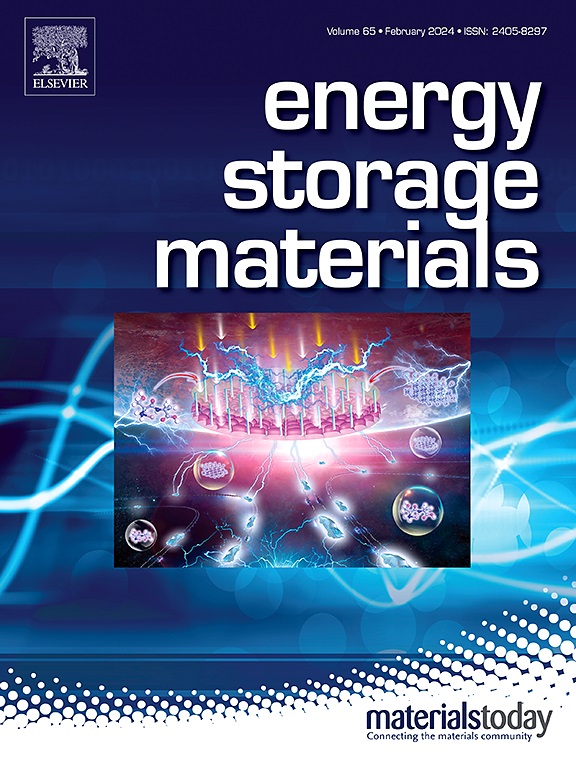为极端环境设计坚固的电解质:克服钠离子电池中的电压和热约束
IF 20.2
1区 材料科学
Q1 CHEMISTRY, PHYSICAL
引用次数: 0
摘要
钠离子电池(SIBs)由于其成本效益和丰富的钠资源而成为大规模储能的有希望的候选者。然而,在以高压极化和持续热应力为特征的极端条件下运行,主要由界面降解、电解质分解、晶格氧释放、不可逆相变和级联失效机制驱动,带来了重大的安全挑战。在这篇综述中,我们系统地研究了用于能够在极端温度和高压条件下工作的sib的坚固的非水液体电解质(NLEs)的开发进展,并对热应力和高能量密度带来的挑战进行了全面分析。随后,我们将重点放在恶劣操作环境引起的基本失效机制上,提出了包括钠盐优化、溶剂/添加剂选择、浓度效应调节和氢键网络工程在内的可行稳定策略的综合框架。此外,从电解质工程过渡到电极-界面相互作用,我们批判性地评估了不同电极-电解质系统的热和高压兼容性。在此综合评估的基础上,我们从人工智能、新型电解质设计、内在机制和降解模型的角度对电解质工程提出了有价值的见解,从而指导了采用具有增强热稳定性和电化学稳定性的先进NLEs的实用电池技术的未来发展。本文章由计算机程序翻译,如有差异,请以英文原文为准。
Designing robust electrolytes for extreme environments: Overcoming voltage and thermal constraints in sodium-ion batteries
Sodium-ion batteries (SIBs) have emerged as promising candidates for large-scale energy storage due to their cost-effectiveness and abundant sodium resources. However, operation under extreme conditions characterized by high-voltage polarization and sustained thermal stress poses significant safety challenges, primarily driven by interfacial degradation, electrolyte decomposition, lattice oxygen release, irreversible phase transitions, and cascading failure mechanisms. In this review, we systematically examine the progress in developing robust non-aqueous liquid electrolytes (NLEs) for SIBs capable of operating under extreme temperatures and high-voltage conditions, and provide a comprehensive analysis of the challenges imposed by thermal stress and high energy density. Subsequently, we focus on the fundamental failure mechanisms arising from harsh operational environments, proposing a comprehensive framework of feasible stabilization strategies encompassing sodium salt optimization, solvent/additive selection, modulation of concentration effects, and hydrogen-bonding network engineering. Furthermore, transitioning from electrolyte engineering to electrode-interface interactions, we critically evaluate the thermal and high-voltage compatibility of diverse electrode-electrolyte systems. Building upon this comprehensive assessment, we present valuable insights into electrolyte engineering from the perspectives of artificial intelligence, novel electrolytes design, intrinsic mechanisms, and degradation models, thereby guiding the future evolution of practical battery technologies employing advanced NLEs with enhanced thermal and electrochemical stability.
求助全文
通过发布文献求助,成功后即可免费获取论文全文。
去求助
来源期刊

Energy Storage Materials
Materials Science-General Materials Science
CiteScore
33.00
自引率
5.90%
发文量
652
审稿时长
27 days
期刊介绍:
Energy Storage Materials is a global interdisciplinary journal dedicated to sharing scientific and technological advancements in materials and devices for advanced energy storage and related energy conversion, such as in metal-O2 batteries. The journal features comprehensive research articles, including full papers and short communications, as well as authoritative feature articles and reviews by leading experts in the field.
Energy Storage Materials covers a wide range of topics, including the synthesis, fabrication, structure, properties, performance, and technological applications of energy storage materials. Additionally, the journal explores strategies, policies, and developments in the field of energy storage materials and devices for sustainable energy.
Published papers are selected based on their scientific and technological significance, their ability to provide valuable new knowledge, and their relevance to the international research community.
 求助内容:
求助内容: 应助结果提醒方式:
应助结果提醒方式:


